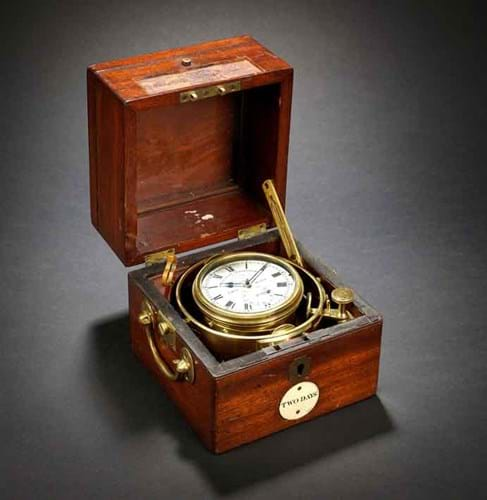
This was a mahogany cased example dated 1825 made by William Edward Frodsham of the famous clockmaking family (he was the son of William James and younger brother of Henry). Tragically drowned at the age of 20, his horological output is scarce.
The chronometer was signed to the dial and numbered 2 and additionally inscribed to the backplate, William Edward Frodsham, AD 1825, London. It also bore an inlaid brass X mark and its ordnance arrow had been removed, showing that it had been de-accessioned from Government use.
The vendor had acquired the piece around 30-40 years ago and knew that Frodsham was a significant chronometer maker, but it was Bonhams' specialist Charles Crisford who researched the records and pieced together the rest of the background to uncover the fascinating history of this instrument.
Admiralty Purchase
Like many marine chronometers, and as indicated by the de-accession marks, this instrument (Frodsham 2) was purchased by the Admiralty after being entered in the Greenwich trials in 1829-30. The Admiralty kept detailed records of their chronometers which allowed its history to be traced. Ledger entries showed that it had served in 15 ships between 1831 and 1911 when it was acquired by Dent and Co.
Two of those voyages are particularly high-profile. Firstly, it was one of 22 chronometers that accompanied Robert Fitzroy on his second voyage in the Beagle in 1831. Today this voyage is best known because Charles Darwin volunteered to travel as ship's naturalist and made his famous trip to the Galapagos Islands and much more.
But Fitzroy's and the Beagle's main task was to survey the coast of South America and to take a series of chronometric measurements on a global circumnavigation to establish longitude. It required a bank of chronometers to ensure accuracy and of the 22 taken (11 of which were Government property) only two are known to have survived, so the appearance of Frodsham 2 adds a third.
Boundary Expedition
The chronometer's other significant journey, this time in 1843, was as one of the four box and seven pocket chronometers used on the arduous North American Boundary expedition to accurately map the frontier between the United States of America and British North America (Canada).
As a Frodsham chronometer alone, Bonhams' James Stratton said the value of this instrument would be around £5000-10,000, but the Beagle associations added significantly to the attraction and the auctioneers guided the piece at £30,000-50,000 for the sale on July 9.
In the event it sold for £60,000, going to a buyer in the room who purchased it for its Beagle connections against an underbidder on the phone.





